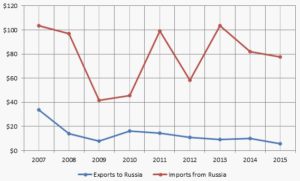By Benjamin Katzeff Silberstein
Some days ago, the Food and Agriculture Organization (FAO) sounded the alarm bells on North Korean food production. The drought of last summer, among other factors, has caused North Korea’s food production to drop for the first time since 2010. (Recall that in the past years, both North Korean media outlets and some analysts touted Kim Jong-un’s agricultural reforms — the former claimed that food production was increasing despite the drought. It seems they spoke too soon).
Numbers like this, however, matter little without context. After all, five years is not a very long measurement period. Analysts like Marcus Noland have noted that the years following 2010 were probably exceptionally good. The current downturn might be best contextualized as a return to lower but more normal levels of food production.
How does the latest food production figure look in a larger context? The short answer is: not that bad, even though the downward trend is obviously problematic. Let us take a brief look at North Korean food production figures over the past few years. All following numbers show food production figures in millions of milled cereal equivalent tons:
- 2008/2009: 3.3
- 2010/2011: 4.5
- 2012/2013: 4.9
- 2013/2014: 5.03
- 2014/2015: 5.08
- 2015/2016: 5.06
(Sources for all figures except the 2015/2016 figure can be found here, in a piece I wrote for 38 North late last year. It seems the calculation I made for 2015/2016 was off by 0.01 million tonnes.)
In other words, yes, the latest food production estimate represents a decrease, but it’s not that big. North Korean food production is still far larger than it’s been for most of the 2000s.
It is also interesting to note the striking variation in North Korean government food imports. Marcus Noland and Stephan Haggard wrote in Famine in North Korea that the government downsized food imports as a response to increasing aid flows. Whatever the rationale might be behind the regime’s food import policies, they tend to vary greatly from year to year. In 2012/2013, the country imported almost 400,000 tonnes of cereal. In the mid-2000s, imports were close to one million tonnes, and they dropped to under 300,000 tonnes in 2008/2009. In 2011/2012, imports climbed to 700,000 tons.
For 2015/2016, FAO projects a gap of need versus production of 694,000 tonnes, but government imports stand at around 300,000 tonnes, a relatively low figure in a historical context. Thus, North Korea is left with an uncovered deficit of 384,000 tonnes. Presumably, this wouldn’t be prohibitively expensive to cover by doubling cereal imports. The economy seems far more healthy today than it was in 2011-2012, and still, it managed to import more than double its planned imports of 2015-2016.
All in all, North Korea’s food production appears to be far from sufficient or stable, but the situation does not appear acute in a historical context. Indeed, one could argue that it’s a matter of policy choices and priorities: the regime could choose to increase imports to offset the decline in production, but its funds are spent elsewhere. And, of course, more efficient agricultural policies overall would make North Korean agriculture and food markets far more resilient to weather variations.

